New Sustainable and Aesthetic Options in Finishing Borders (Wall Base)
Select the best solution to conceal the gap between the wall and floor
![]() Continuing Education
Continuing Education
Use the following learning objectives to focus your study while reading this month’s Continuing Education article.
Learning Objectives - After reading this article, you will be able to:
- Explain the difference between toe and toeless styles of wall base and identify the applications for which each is best suited.
- Compare popular wall base materials in terms of performance, sustainability and cost.
- Consider new bio-based and wood alternative wall base solutions for healthcare and commercial applications.
- Specify the wall base that best meets the aesthetic, performance and sustainability demands of the project.
Finishing borders, also referred to as wall base, are the architect’s solution for concealing the gap between the wall and the floor in the built environment. This building component provides the finishing touch to a space as well as general protection from the open exposure between the drywall and the floorboards.
In the past, designers have chosen the right wall base for a project based on the color, style, material and cost. Now, as the design community and building owners become more invested in the idea of green building and sustainable design, designers want the ability to evaluate wall base solutions on the basis of the product’s overall sustainability as well.
Today, designers can select a wall base that will provide the desired aesthetic, perform as needed, meet budgetary demands, and contribute toward the project’s sustainability objectives and it can make this contribution throughout a building, wherever the walls meet the floor.
The Basics for Selecting a Wall Base
Traditionally, when a designer selects a wall base for a project, the material, shape (style), size, performance and price point are all considered.
Materials
Wall base is available in a variety of materials, including, wood, steel, carpet, rubber and vinyl. Today, wall base made of rubber and vinyl, often referred to as resilient wall base, can offer specifiers a less expensive wall base solution that is without the issues of durability, fit, and maintenance commonly experienced when wood, steel, or carpet wall base is selected for a job.
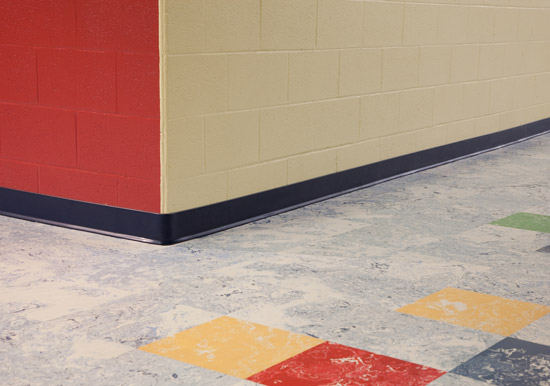 |
New sustainable and aesthetic wall base solutions offer designers more options for concealing the gap between the wall and the floor. Photo courtesy of Tarkett |
Performance Considerations
Wall base adds an important finishing touch to a space, making it feel and look complete. Selecting a wall base that will maintain its aesthetic appeal with minimal maintenance is a typical performance objective. However, not every wall base material is capable of being a virtually maintenance-free, aesthetically uncompromised wall base over time. Wood naturally swells and shrinks in response to changes in temperature and humidity. This shape shifting often causes a wood wall base to separate from the wall. It can also cause the paint coating on the wood to chip, crack and peel and require that the wall base be repainted to restore the aesthetic appeal. In terms of withstanding wear and tear, wood may be one of the least durable wall base materials available, as ordinary use may create dents and dings in the physical wood. Once the physical wood is damaged, it may need to be replaced, instead of repainted, to restore the aesthetic. Carpet can fray over time and keeping the fabric clean and stain-free can present more of a maintenance challenge than may have been considered when the material was initially specified.
Good fit is another important objective of a wall base. Stainless steel is very low maintenance, and very durable, but the material itself is not very forgiving and this can limit the ability of a stainless steel wall base to adapt to any inconsistencies that may exist in the built space and may compromise the overall fit that it may provide once installed.
Resilient wall base, made of rubber or vinyl, is a low maintenance wall base that resists scuffing, fading and cracking. It addition to its impressive durability, resilient wall base will not shrink or separate from the wall. Traditional resilient wall base is not painted, so it will never need to be repainted, and it is a surface that is easy to clean and disinfect. It is also more flexible and forgiving than other materials, so it can easily accommodate imperfections in the built environment and it is just as easily installed along a straight wall or a circular column.
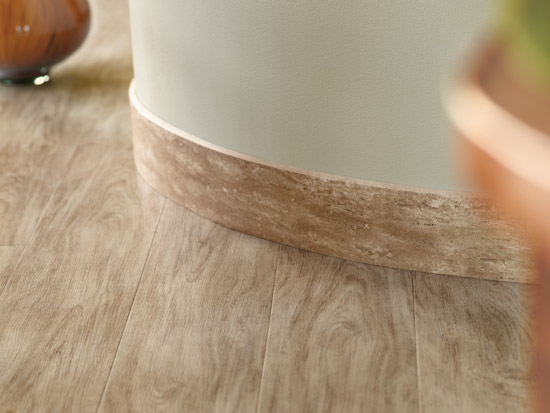 |
Resilient wall base is flexible and easily wraps around circular columns. Photo courtesy of Tarkett |
Style
A common question designers have about wall base products relates to the difference between the styles. In the world of wall base, there are many names for essentially two styles. One style of wall base is referred to as flat, straight, or toeless. This straight or toeless style of wall base runs straight from the top of the wall base to the bottom, without any type of sculptured or indentation detail. This style of wall base is best suited to applications with carpet. The other style of wall base is often called toe or cove. This wall base style, as the name may indicate, has a toe at the bottom of the wall base that curves outward to cover the gap. The toe or cove wall base style is best matched to vinyl, rubber, wood or tile floors.
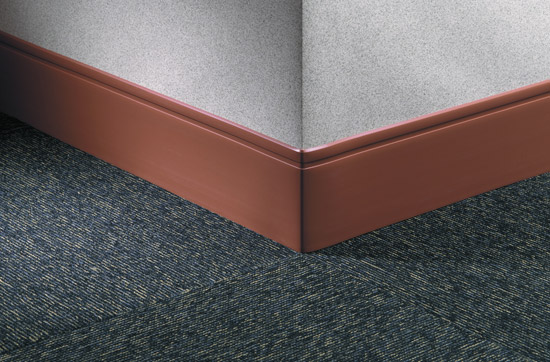 |
While flat wall base runs straight to the floor, wall base with toe curves outward at the bottom of the border. Photo courtesy of Tarkett |
Size
Across the industry, wall base is typically available in three standard heights and two thicknesses. The three standard heights are 2.5” (6.4cm), 4.0” (10.2cm), 6.0” (15.3cm). Selecting the height of a wall base is, in many applications, almost an exclusively aesthetic decision. One exception is healthcare institutions, where many designers prefer to specify wall base that is 6.0” or higher to offer a greater degree of wall protection.
The two thicknesses are 1/8-inch (3.2mm) and 0.080-inch (2.0mm). The 1/8-inch thickness offers better coverage for camouflaging wall inconsistencies. The 0.080” thickness is a value option, which usually has a lower material cost, but doesn’t cover issues in the built environment well. The thinner wall base is often found in tenant improvement situations where cost is the primary consideration.
Cost
While product costs vary from manufacturer to manufacturer, generally speaking, stainless steel wall base is the most expensive. Wood and carpet wall base are less expensive than stainless steel, while resilient wall bases, made from rubber and vinyl, are often the least expensive of the bunch.
Three Types of Resilient Wall Base
Resilient wall base offers specifiers a unique blend of durability, flexibility, and cost effectiveness. The overwhelming advantages of these resilient wall base solutions may explain why resilient wall base is so commonly found throughout commercial, institutional, and healthcare buildings today. However, there are different types of resilient wall base. In order to specify the right resilient wall base throughout a project, it is important to understand the three different materials most commonly used in resilient wall base, how these materials are different, perform differently and possess different sustainable attributes.
There are three materials commonly used to create resilient wall base throughout the industry. They are thermoplastic vinyl (TV), thermoplastic rubber (TP) and thermoset rubber (TS).
Thermoplastic Vinyl (TV)
Thermoplastic vinyl (TV) is a composite of polyvinyl chloride (PVC) and is thermoplastic, which is a polymer that becomes pliable at high temperatures. This material is often used in the construction industry as electrical insulation, tubing, and even upholstery. Of the three materials often used to create resilient wall base, TV is the least expensive. TV will repeatedly soften when heated and stiffen when cooled and after being heated and cooled many times, the material only exhibits a slight loss of its original characteristics.
Thermoplastic Rubber (TP)
Thermoplastic rubber (TP) is a synthetic rubber compound that may or may not contain vinyl, and does not require chemical vulcanization, a process of treating rubber to improve its elasticity and strength. TP will repeatedly soften when heated and stiffen when cooled and after being heated and cooled many times, the material only exhibits a slight loss of its original characteristics.
Thermoset Rubber (TS)
Thermoset rubber (TS) is the original resilient wall base material. It is made of natural and/or synthetic rubber and it is the wall base material that is often specified by default when architects use legacy specifications. This material does undergo a chemical vulcanization.
Compare the Performance of TV, TP, TS
The American Society for Testing and Materials (ASTM) wrote a performance specification for resilient wall base titled the ASTM 1861 Standard Specification for Resilient Wall Base (ASTM F1861). The specification details dimensional and performance requirements that include color stability, flexibility and chemical resistance. In the ASTM performance specification, all three materials TV, TP, and TS are identified as acceptable, with no differentiating statements on where certain materials are better suited.
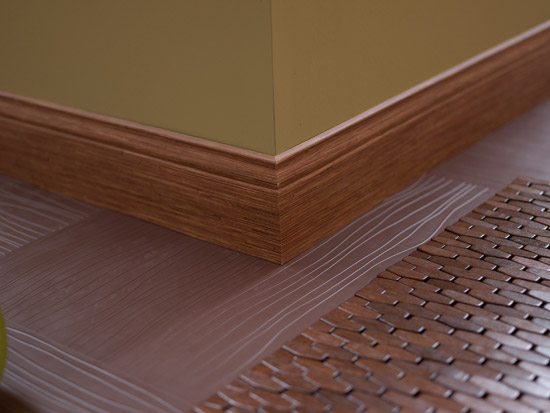 |
The ASTM performance specification for resilient wall base recognizes TV, TP, and TS wall base materials as acceptable. Photo courtesy of Tarkett |
Wall base made from TV, TP and TS are similar in many ways. All of the materials give the wall base the flexibility to conform to variations in the wall or floor surface. They offer excellent chemical resistance and great color stability. They also meet the ASTM F1861 dimensional and performance standards as outlined.
But TV, TP and TS are different materials that do, in fact, perform differently. Some of the differences are aesthetic. For example, the TS surface provides a predominately matte finish, while the TP wall base offers a surface that is smooth and consistent. Some of the differences are much more critical. For example, different types and brands of wall base can perform dramatically differently when the room is filled with fire and smoke.
Fire Resistance / Fire Rating
The fire resistance/Class rating required for wall base used in certain applications is determined by a number of factors, including, but not limited to:
– The version of the International Building Code (IBC) that has been adopted by the state in which the job is being done. Across the United States, different states have adopted different versions of the IBC.
– Any local codes which exceed or supercede the requirements of the IBC.
– The height of the wall base being specified. Depending on the height, a different test may be required, i.e. critical radiant flux, versus flame spread index.
– The area of the building in which the wall base is being installed. Typically, emergency exit ways have a more stringent requirement for fire resistance than does a conference room which has sprinklers.
For example:
• The state of Maryland, has adopted the 2012 IBC. The 2012 IBC requires that interior floor-wall base that is 6 inches or less in height shall be tested for critical radiant flux in accordance with NFPA 253 (ASTM E-648), and the rating shall not be less than Class II. Where a Class I floor finish is required, the floor-wall base shall be a Class I (highest).
• For floor-wall base that is over 6 inches in height, but less than 10% of the specific wall area, the 2012 IBC requires that it is treated as interior trim, which has a minimum Class C flame spread and smoke developed index when tested in accordance with ASTM E-84 (UL 723).
• New York City has its own building code which supercedes the 2006 IBC which has been adopted by the state of New York. The NYC building code has a much more stringent requirement for flame spread & smoke developed index for emergency exit ways than even the latest version of the IBC.
This is not intended to be a comprehensive discussion of fire resistance/fire rating for wall base, but simply a demonstration of how many different factors come into play when selecting a wall base to meet the requirements. It is very important, for each project, to know what codes apply to that location and which products meet those requirements. Each manufacturer publishes the Class ratings for each of their resilient wall base products. Keep in mind that even within each type of wall base (TV, TP & TS), different manufacturers may have a different Class rating.
Considering Sustainability
Beyond building codes and budgets, the overall sustainability of a product is another consideration that more and more designers are becoming inclined to make before specifying any material. Evaluating the sustainable nature of a product requires a review of not only its material contents, but also its manufacturing processes and whether the product is ultimately reused or recycled.
Identifying the criteria that will be used to evaluate the sustainability of a product lays the foundation for being able to compare the sustainability of one product with another. These criteria can vary from designer to designer and, even, from project to project within a designer’s portfolio, depending upon the type of project, project objectives, and unique client preferences. In this article, the sustainable nature of various wall base solutions will be evaluated on the basis of the type of material used for the wall base, the environmental impact of the manufacturing processes employed to create the wall base, and whether or not it is possible to reuse or recycle the product.
Selecting More Sustainable Materials
The term sustainable material refers to a material that is generated from a resource that is managed in a way or replenished with a frequency, where it is considered, for all practical purposes, to be available into and beyond the foreseeable future. On the continuum between rapidly renewable resources and non-renewable resources, the more readily renewable the resource, the more sustainable the material is considered to be. A rapidly renewable resource is defined as being plant-based and having a harvest cycle of 10 years or less. Examples of rapidly renewable resources include bamboo, agrifiber, cotton, and natural rubber, a material used in certain types of resilient wall base.
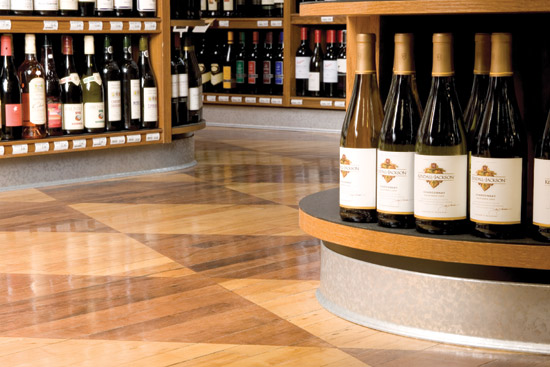 |
Certain types of resilient wall base are made from natural rubber, a rapidly renewable resource. Photo courtesy of Tarkett |
Products containing recycled materials can also offer a more sustainable product solution. Specifying products that contain recycled materials actively diverts materials from the waste stream, and the landfill, for recycling and reuse. Resilient wall base that contains some level of recycled content is also now available on the market.
Comparing the Materials in TV, TP, TS Wall Base
As previously mentioned, TV, TP and TS are three different types of resilient wall base manufactured from three different material blends. These various material blends can have different sustainable properties. For example, TV wall base can contain recycled content, while TS wall base can contain different amounts of natural rubber, a rapidly renewable resource.
Selecting Non-Toxic Materials
A material can continue to impact an environment, even after it is removed from the ground. Some materials release a gas into the interior environment, after they have been processed and installed, a phenomenon called off-gassing. Look for wall bases that have low volatile organic compound (VOC) emissions and meet the requirements of CA01350 to ensure good indoor air quality, which affects the wellbeing and health of people in spaces.
Phthalates and polyvinyl chloride (PVC) are often used in manufacturing resilient wall base to improve the flexibility and durability of the product. Some manufacturers have changed their plasticizers for phthalate alternatives making them safe solutions to use in interior spaces. Concerns have been raised about the impact that phthalates can have on the air quality of the interior environment and the health of building occupants. It is important for the specifier to use low emitting wall base and consider products that are made with alternative types of plasticizers.
There is a new pilot credit in LEED 2009 that promotes chemicals of concern avoidance. This new pilot credit, entitled Avoidance of Chemicals of Concern, is pilot credit 54 in the Materials and Resources category (MRpc54) and it was written with the intent of “reducing the concentration of chemical contaminants that can damage air quality, human health, productivity, and the environment.” This pilot credit was closed to new registrations on February 15, 2013. Projects that registered for the credit prior to February 15, 2013 can continue to pursue it.
It should be noted that there is some controversy that surrounds the opinion that the presence of phthalates and PVC reduces the overall sustainability of a product. While one side points to the adverse health effects that these products may contribute, others cite the increased longevity that the use of PVC and phthalates can provide, which dramatically reduces the total amount of product that will be placed in a landfill every year. All PVCs are not made equal; some made with phthalate alternatives and low emissions are sustainable products to use in interiors. Specifiers will need to consider the unique needs and objectives of each individual project to identify whether the presence or absence of phthalates or PVC is in its best interest.
Phthalates and PVC in TV, TP, and TS
Depending upon the needs of the project, there is a resilient wall base that will offer a specifier the right presence of phthalates and PVC. TV contains PVC and is available in products that do and do not contain phthalates. Wall base made from TP may or may not contain PVC and may or may not contain phthalates. Wall base made from TS is both phthalate-free and PVC-free.
Efficient Manufacturing Processes
The efficiency of a manufacturing process relates to both the energy consumed for the manufacturing process and the waste created during the process. More efficient processes consume less energy and create less waste.
The Differences in Manufacturing TV, TP, TS
Wall base made from thermoplastic materials, which include both TV and TP wall base, are manufactured by heating the thermoplastic material until it melts and then shaping it and cooling it to give it its desired shape. Thermoset products, like TS wall base, undergo a chemical process that changes the molecular structure of the material and cures it into its shape.
When comparing the energy consumption of the two processes, it takes more energy to heat a material enough to change it at a molecular level than it does to simply change its shape. So it follows that it takes more energy to manufacture a wall base made from TS than one made from a thermoplastic blend like TV or TP.
There are certain aspects of the wall base production process that directly affect the amount of waste that can be produced. The use of dye lots in a product is one such aspect. If dye lots are not used during production, the amount of waste and scrap material produced is reduced throughout the supply chain.
Recycle Wall Base
Specifying wall base that can be recycled makes it possible to divert these materials from the landfill, once its time as wall base is over, and repurpose them to be used again and again.
Recycling TV, TP, TS
Thermoplastic wall base, like TV and TP wall base, can be ground up and reprocessed, allowing it to be recycled in a wide variety of ways. Thermoset materials, like TS wall base, are more limited in the ways that it can be recycled; because the chemical curing process that gives the TS wall base its initial form changes the material at a molecular level and makes it impossible to reshape it. When reheated, thermoset materials will decompose before melting, so TS wall base can be ground up and used as filler in other products, such as playgrounds, or mulch, but it cannot be melted down and reshaped.
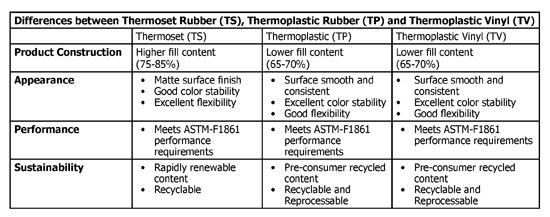 |
Although all compliant with ASTM performance requirements, TS, TP, and TV wall base do appear different, perform differently, and embody different sustainable characteristics. Photo courtesy of Tarkett |
New Bio-Based Wall Base
Technological advancements and material innovation now make it possible for designers to specify a new bio-based wall base that offers sustainable characteristics that are far beyond anything available in the more traditional TV, TP and TS materials, without sacrificing performance. This more sustainable wall base solution meets all of the performance requirements of the ASTM-F1861, Standard Specification for Resilient Wall Base.
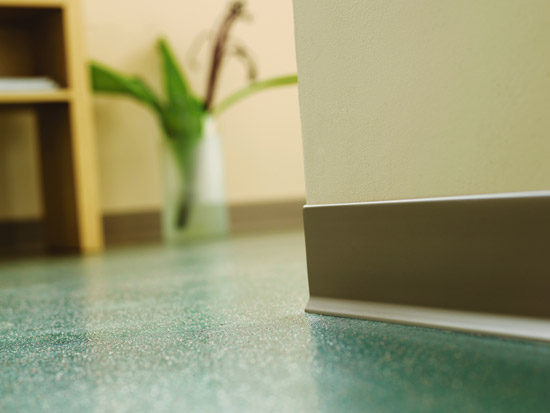 |
New bio-based wall base contains rapidly renewable resources that include: walnut shells, pine rosin, and vegetable oil. Photo courtesy of Tarkett |
This new bio-based wall base contains rapidly renewable materials that include walnut shells, pine rosin and vegetable oil. Even the fillers in this bio-based solution are natural materials like walnut shells and oyster shells. The sustainable nature of this product enables it to be used to contribute toward earning LEED points in the satisfaction of the LEED MR credit 6 (MRc6) entitled 5 Percent Rapidly Renewable Content.
Beyond containing more readily renewable materials, the bio-based wall base is phthalate-free and PVC-free, like TS wall base, but is manufactured in a more energy efficient process than the chemical curing that TS requires. These materials can also be reprocessed and repurposed into a wide variety of products.
New Options for a Wood Wall Base
Designers are looking for more than sustainable wall base solutions. New wall base products are emerging to support the current trend in healthcare settings where institutions are being designed to convey a more residential look and feel. Designers are increasingly incorporating more wood and wood-aesthetic throughout a space. Now resilient wall base products are available in a wood finish that will achieve the warmer, residential appearance, without opening the space to the performance issues, like cracking or separating from the wall, commonly experienced with traditional wood wall base.
 |
New wood finish resilient wall base products offer the warmth and aesthetic appeal of wood in a solution that is resistant to cracks and scuffing and able to withstand rigorous cleaning and harsh disinfectants. Photo courtesy of Tarkett |
The selection of resilient wall base designed to offer a wood aesthetic continues to grow and there are more profiles, more colors, and more finishes available than ever before. The straight and toe styles of resilient wall base can be selected in a variety of wood grain finishes. There is even a resilient wall base product with a profile that resembles a piece of wood that has been milled. Instead of a flat, straight wall base, these wall base products incorporate a contour that mirrors the shape often found in real wood molding.
This contoured resilient wall base offers a heightened wood aesthetic in a solution that is resistant to scuffing, fading and cracking. In addition, these wall base solutions are free of knots and nail-heads and they will not splinter, chip or absorb liquids. These products are a great option for healthcare settings as they provide the residential look and feel, while being able to withstand the harsh disinfectants and more rigorous cleaning regimens employed in a healthcare facility.
Wall Base Creates Visual Interest
Now resilient wall base can be used to create visual interest in a space as well. High-definition, digital imaging technology prints directly on the surface of the wall base. Specifiers can select wood grains like rosewood, zebrawood, cherry, maple, and mahogany or stone looks that mimic travertine, veined marble, sandstone, limestone and others.
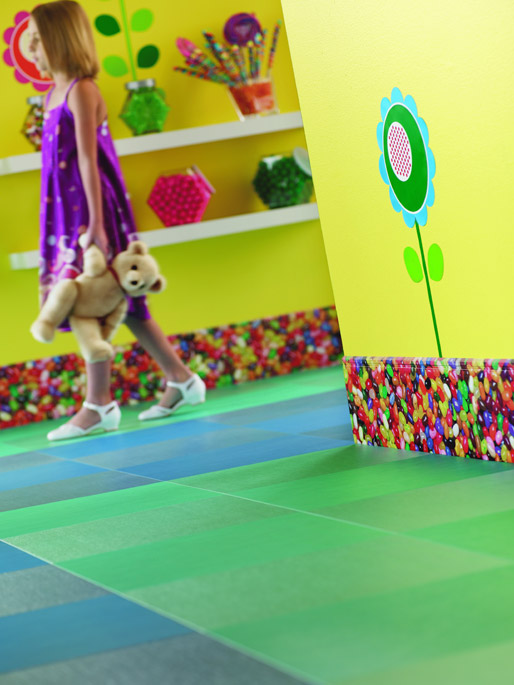 |
Create visual interest with wall base by specifying a high definition print that can mimic exotic materials, patterns, or images. Photo courtesy of Tarkett |
Beyond those standard digital finishes, advanced digital imaging technology makes possible to customize a wall base with virtually any visual image. Designers can choose any exotic wood grain, rock pattern, floral print, abstract pattern, or custom match the fabric in a wall covering or office chair.
In the end, with all of these advancements in wall base, from being manufactured from more sustainable materials, to offering a more durable wood aesthetic, to being able to be digitally printed with any pattern or color imaginable, one thing is for sure: designing for the gap between the wall and the floor is now a lot more interesting.
 |
For more than 100 years, Johnsonite has been a leading provider of innovative flooring solutions that integrate function, design, life safety and sustainability to enhance productivity in commercial spaces. Johnsonite is the North American commercial brand of the Tarkett Group. http://www.johnsonite.com |
